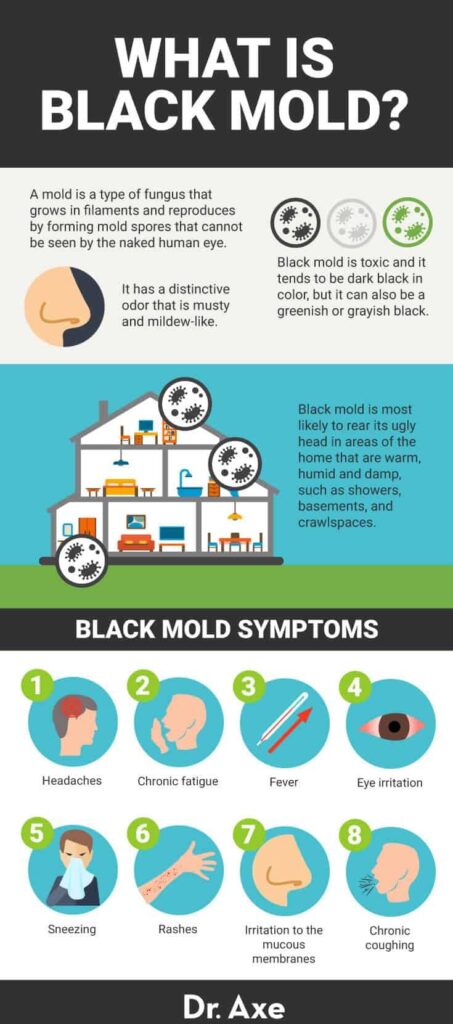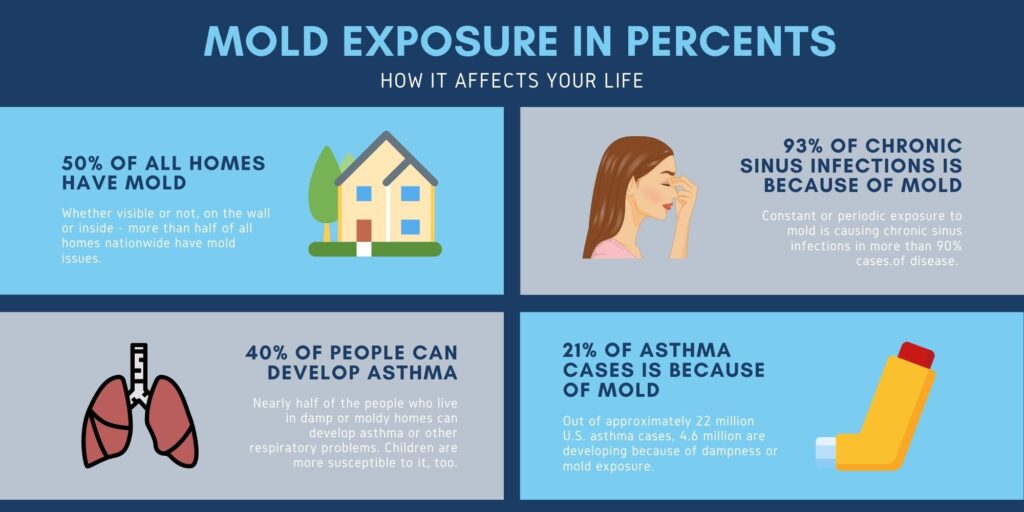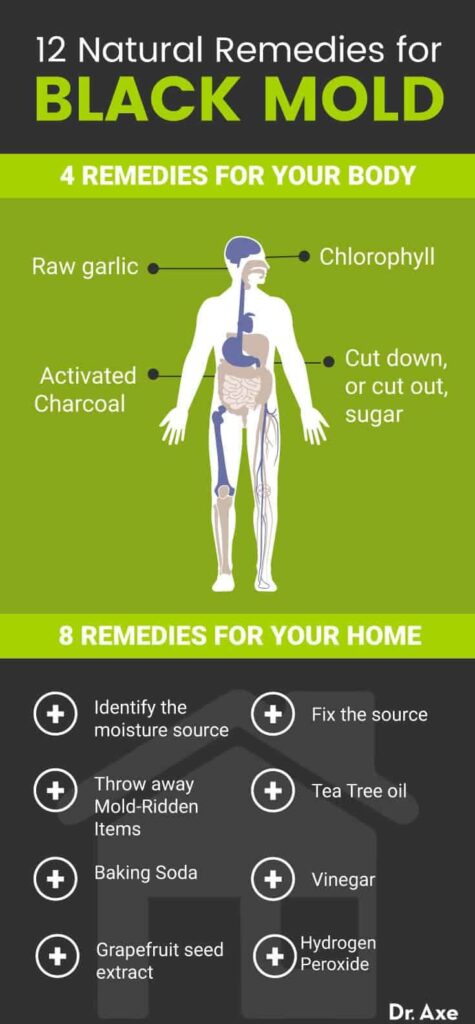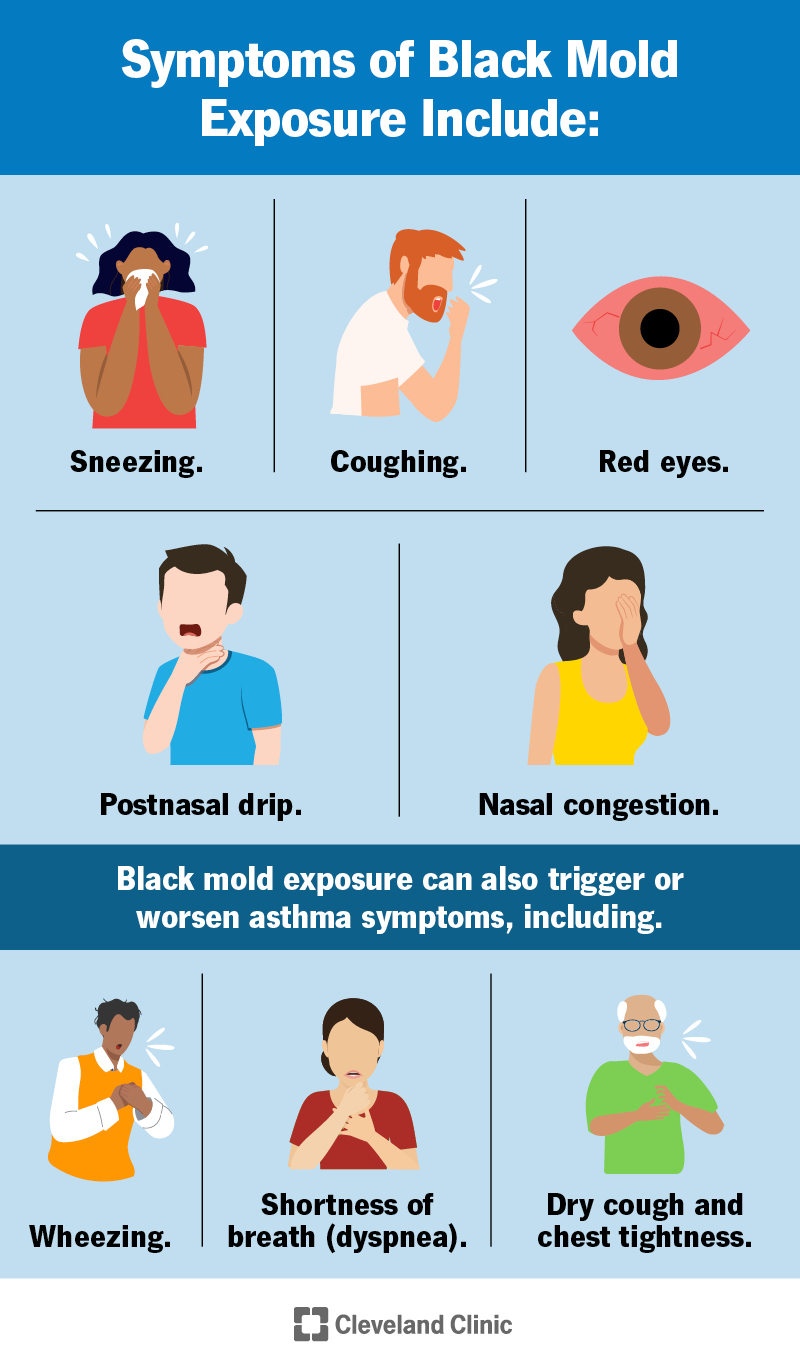In this article, you’ll learn about the signs and symptoms of exposure to black mold and what to look out for. We’ll discuss common indicators of black mold exposure, such as respiratory issues and allergic reactions. You’ll also find out how to identify black mold in your home and what steps to take if you suspect you’ve been exposed. By the end of this article, you’ll have a better understanding of the potential dangers of black mold and how to protect yourself.
What is Black Mold?
Black mold, also known as Stachybotrys chartarum, is a type of fungus that grows in damp environments. It is commonly found in areas with water damage or high humidity levels. Black mold can produce toxic compounds called mycotoxins, which can pose health risks to humans and pets.
Definition
Black mold is a greenish-black fungus that thrives in moist conditions. It is often found on surfaces such as walls, ceilings, carpets, and furniture. This type of mold releases spores into the air, which can be inhaled and cause health problems.
Characteristics
Black mold is characterized by its slimy or powdery appearance. It usually has a dark green or black color, hence its name. When disturbed, black mold can release a musty odor. It thrives in environments with high humidity levels and organic matter, such as wood or paper.
Causes
Black mold is caused by excessive moisture and warm temperatures. It typically grows in areas that have experienced water damage, such as leaky roofs, plumbing leaks, or floods. Poor ventilation and high humidity levels also contribute to the growth of black mold.
Common Locations
Black mold can be found in various areas of a home or building. Some common locations include:
- Basements or crawl spaces that have experienced water damage
- Bathrooms with inadequate ventilation
- Kitchens with plumbing leaks
- Areas around windows with condensation buildup
- Carpeting or upholstery that has been exposed to moisture
- Behind wallpaper or drywall that has been affected by water damage
Health Risks of Black Mold Exposure
Exposure to black mold can have serious health consequences. The mycotoxins released by the mold can cause a range of health problems, including:
Respiratory Issues
Exposure to black mold can trigger respiratory issues, such as coughing, wheezing, and shortness of breath. These symptoms may be particularly severe in individuals with asthma or other respiratory conditions.
Allergic Reactions
Black mold can also cause allergic reactions in some individuals. Symptoms may include sneezing, runny nose, itchy or watery eyes, and nasal congestion.
Neurological Problems
Exposure to black mold has been linked to neurological problems, such as difficulty concentrating, memory problems, and headaches. Some individuals may also experience dizziness, tremors, or mood swings.
Skin Irritations
Direct contact with black mold can cause skin irritations, including rashes, redness, and itching. In some cases, individuals may experience a burning sensation on the skin.

Signs and Symptoms of Black Mold Exposure
Exposure to black mold can lead to various signs and symptoms. It is important to be aware of these indicators and seek medical attention if you experience any of the following:
Persistent Coughing
If you find yourself coughing persistently, especially in specific areas of your home or building, it may be a sign of black mold exposure. Mold spores can irritate the respiratory system, leading to a chronic cough.
Wheezing and Shortness of Breath
Individuals with asthma or respiratory conditions may experience wheezing and shortness of breath in the presence of black mold. These symptoms may worsen in damp or moldy environments.
Sneezing and Runny Nose
If you frequently find yourself sneezing or having a runny nose, it could be a reaction to black mold spores in the air. These symptoms may be particularly noticeable when you are in certain areas of your home or building.
Red and Irritated Eyes
Black mold exposure can cause red and irritated eyes. You may experience itching, burning, or excessive tearing. These symptoms may worsen in rooms with mold growth.
Headaches and Migraines
Headaches and migraines are common symptoms of black mold exposure. These can range from mild to severe and may be accompanied by other symptoms such as dizziness or sensitivity to light.
Fatigue and Weakness
Feeling fatigued or weak even after getting enough sleep could be a result of black mold exposure. Mold toxins can affect the immune system and result in general feelings of tiredness or weakness.
Difficulty Concentrating
Exposure to black mold can affect cognitive function and make it difficult to concentrate. You may find it challenging to focus on tasks or experience brain fog.
Memory Problems
Some individuals exposed to black mold may experience memory problems or have difficulty recalling information. This can be particularly concerning for individuals in school or work settings.
Skin Rashes and Irritations
Direct contact with black mold can lead to skin rashes, redness, or itching. These symptoms may appear on areas of the body that have come into direct contact with mold-infested materials.
Identifying Black Mold in your Environment
It is important to be able to identify black mold in your environment to take appropriate action. Look out for the following signs:
Visible Signs of Mold
Black mold can often be seen on surfaces, such as walls, ceilings, or floors. It may appear as black or green growth and can have a slimy or powdery texture.
Musty Odor
If you notice a musty or earthy odor in certain areas of your home, it could be a sign of black mold growth. This odor is typically strong and distinctive.
Water Leaks and Moisture
Areas with water leaks or excessive moisture are prone to black mold growth. Check for signs of water damage, such as discolored walls, peeling paint, or bulging wallpaper.
Condensation on Windows
Condensation on windows is a common sign of high humidity levels in your home. This moisture can create an ideal environment for black mold to grow.
High Humidity Levels
High humidity levels can promote black mold growth. Use a hygrometer to measure the humidity levels in various areas of your home. Levels above 60% indicate high humidity.

DIY Testing Methods for Black Mold
If you suspect black mold in your environment, there are several DIY testing methods you can use to confirm its presence:
Mold Testing Kits
Mold testing kits are available in hardware stores and online. These kits include swabs or strips that you can use to collect samples. Follow the instructions provided with the kit to test for black mold.
Black Light Testing
Black light testing involves using a UV light source to detect black mold. The mold will fluoresce under the UV light, making it easier to identify.
Tape Sampling
Tape sampling is a simple method for collecting mold samples. Use clear tape to collect samples from suspected mold growth areas. Press the tape onto the surface and then carefully remove it. The collected samples can be sent to a laboratory for analysis.
Professional Inspection
If you are unsure about your DIY testing results or want a more accurate assessment, you can hire a professional mold inspector. They will conduct a thorough inspection of your property and provide you with a detailed report.
Preventing Black Mold Growth
Preventing black mold growth is essential to protect your health and your property. Here are some preventive measures you can take:
Control Moisture Levels
Keep the humidity levels in your home below 60% to inhibit black mold growth. Use dehumidifiers or air conditioners to remove excess moisture from the air.
Fix Water Leaks
Promptly repair any water leaks, such as leaking pipes or roofs. Regularly inspect your plumbing systems and address any issues immediately.
Ensure Proper Ventilation
Proper ventilation is crucial in preventing mold growth. Use exhaust fans in bathrooms and kitchens to remove excess moisture. Open windows and use fans to improve air circulation.
Remove Mold-Infested Materials
If you find mold growth on materials that cannot be cleaned or salvaged, such as carpets or drywall, it is best to remove and replace them. Mold can penetrate porous materials and become difficult to completely remove.
Use Mold-Killing Products
To clean mold-infested surfaces, use mold-killing products such as bleach or hydrogen peroxide. Follow the instructions provided with the product and take appropriate safety precautions.

Treating Black Mold Exposure
If you suspect that you or someone in your household is experiencing symptoms of black mold exposure, it is important to take action. Here are some steps you can take:
Seek Medical Attention
Consult with a healthcare professional to evaluate your symptoms and determine the appropriate course of treatment. They may recommend allergy medication, inhalers for respiratory issues, or other medical interventions.
Reduce Exposure
Limit your exposure to black mold by avoiding areas with visible mold growth. If possible, seal off the affected areas to prevent the mold spores from spreading to other parts of your home.
Improve Indoor Air Quality
Improve indoor air quality by using air purifiers or filters that are designed to remove mold spores from the air. Regularly clean and maintain the filters to ensure their effectiveness.
Consult with Mold Remediation Experts
If you are unable to effectively remove black mold from your property or if the infestation is widespread, it is recommended to consult with mold remediation experts. They have the knowledge, experience, and equipment to safely and thoroughly remove black mold.
Common Misconceptions about Black Mold
There are several common misconceptions about black mold that need to be addressed:
All Black Mold is Toxic
While black mold can produce mycotoxins, not all black mold is toxic. The toxicity of black mold depends on various factors, including the type of mold and the concentration of mycotoxins present.
Only Old Buildings are Affected
Black mold can grow in both old and new buildings. Any environment with excessive moisture or water damage is at risk of black mold growth.
Not a Serious Health Threat
Exposure to black mold can have serious health consequences, especially for individuals with respiratory conditions or weakened immune systems. It is important to take black mold exposure seriously and seek appropriate medical attention.

Legal and Insurance Considerations
When dealing with black mold, there are legal and insurance considerations that may come into play:
Insurance Coverage
Check your insurance policy to determine if it covers black mold damage. Some policies may have specific exclusions or limitations for mold-related claims.
Landlord and Tenant Responsibilities
If you rent a property, it is important to understand your responsibilities as a tenant and your landlord’s responsibilities for addressing black mold issues. Consult your lease agreement and local tenant laws for guidance.
Health and Safety Regulations
Familiarize yourself with health and safety regulations related to black mold in your area. These regulations may provide guidelines for preventing, testing, and addressing mold issues.
Conclusion
Exposure to black mold can have serious health consequences. It is important to be aware of the signs and symptoms of black mold exposure and take appropriate action if you suspect mold growth in your environment. By identifying and preventing black mold growth, seeking medical attention when necessary, and following legal and insurance considerations, you can protect your health and well-being.
